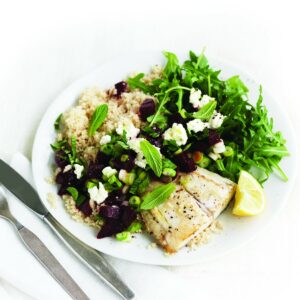
Shopping for a low-FODMAP diet can be expensive. There are ways, though, to make sure your grocery bill doesn’t break the bank:
1. Plan your meals and write a shopping list
Planning out your weekly meals means you can write a detailed shopping list. This helps you from wandering aimlessly around the supermarket and should also help stop impulse buying!
2. Check out independent greengrocers, Asian supermarkets, and butchers in your area
They often have lower prices and good-quality produce. Independent butchers generally allow you to buy the exact quantity of meat you need, which can save you a lot of money.
3. Cook extra for dinner and take leftovers for lunch
It’s much cheaper to cook in bulk, and it reduces the amount of meal prep work you need to do each week. Leftovers can be stored in containers and taken to work the next day or popped in the freezer for a later date.
4. Re-grow your spring onions and leeks
A low-FODMAP diet means we can only use the green tips of both spring onions and leeks. Once you have harvested the tips, place the spring onion bulbs and leek bulbs in glasses of water on your window sill. They will begin to reshoot after a couple of days. After about a week I transfer mine into a planter box and then continue to harvest the green tips as I need them.
5. Use frozen vegetables (especially green beans) and berries
These are just as nutritious as fresh, and generally much cheaper. Using frozen produce also reduces waste as it keeps for months in the freezer.
6. Invest in a selection of dried herbs or grow your own fresh herbs
Dried herbs are relatively cheap compared to fresh herbs and they last for months in the pantry. If using dry instead of fresh, reduce the amount by three. This means if a recipe calls for one tablespoon of fresh herbs, use just one teaspoon of dried herbs (1 tablespoon = 3 teaspoons). Another cost-saving tip is to grow your favourite herbs in pots on your deck or windowsill. My favourite herbs to grow are parsley, basil, coriander and chives.
7. Focus on using potatoes, rice, and rice noodles as fillers in your meals
Keep gluten-free pasta as an occasional treat. Unwashed potatoes are cheaper than washed potatoes. Also, the trick to good rice noodles is to avoid overcooking them, so check the noodles two minutes before they are meant to be ready.
8. Save money on meat
Tinned fish like tuna and salmon, lean minced meat and eggs are cheap and versatile sources of protein. When choosing tinned fish make sure you buy plain flavours and check for high-FODMAP ingredients. Remember to bulk out your meat-based meals with several low-FODMAP vegetables and low-FODMAP fillers like rice or potato.
9. Make your own lactose-free milk
Lactose-free milk is significantly more expensive than standard cow’s milk, but you can make your own by adding lactase drops to standard cow’s milk and leaving it for 24 hours before consuming. The lactase enzymes digest the lactose, making it low FODMAP. Lactase drops are available over the counter at most pharmacies (Varney, 2015).
10. Do your own gluten-free baking
Gluten-free baking from the supermarket is expensive. Try baking your own gluten-free items and storing them in the freezer. That way you always have a low-FODMAP treat when you need one. For low-FODMAP baking ideas check out www.alittlebityummy.com.
11. Carry a water bottle
Key to having a healthy body is staying hydrated. Bottled water is expensive and the plastic waste we generate each day from disposable bottles is a threat to the environment. So do your budget and the environment a favour and carry a reusable water bottle!
Original article sourced from https://www.alittlebityummy.com/blog/11-budget-saving-tips-for-the-low-fodmap-diet/
Article sources and references
- Varney J. Low FODMAP diet on a budget. Monash Low FODMAP Blog. 2015-05-17https://www.monashfodmap.com/blog/low-fodmap-diet-on-budget/
www.healthyfood.com










